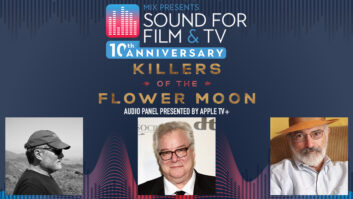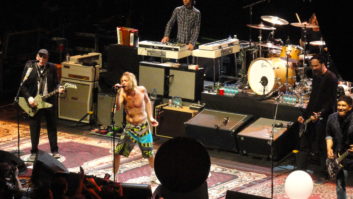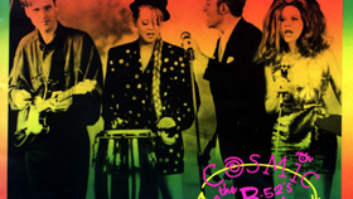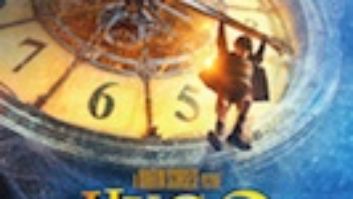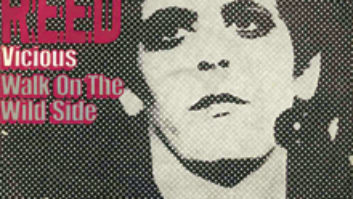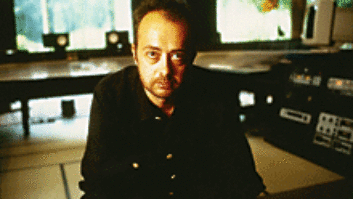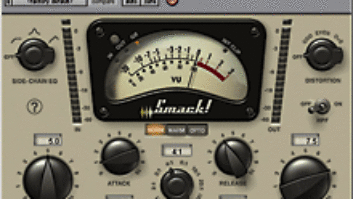Director Martin Scorsese is back on New York City’s Mean Streets. No, it’s not Little Italy, where much of the action in his critically lauded breakthrough film of 30 years ago —Mean Streets— took place. And it’s not the New York ofTaxi Driver, After Hours, King of Comedy, GoodfellasorBringing out the Dead. Temporally,Gangs of New Yorkis closest to his underrated 1993 costume drama,Age of Innocence, which was set in the genteel environs of upper-class New York society in the late-19th century. But even that feels worlds away from the grit, poverty, desperation and violence ofGangs of New York, Scorsese’s sprawling story of Irish immigrant struggles in New York during the mid-19th century.
Fleeing from famine in their homeland, Irish immigrants arrived in New York by the thousands in the 1840s and ’50s; by 1860, the city’s population was more than one-quarter Irish. Most arrived with little more than the clothes on their backs and were forced to move into dense, squalid neighborhoods — such as Manhattan’s notorious Five Points area — where they eked out a meager living however they could. They were treated terribly by the local powers-that-be and despised by other groups in the city because they represented competition for already-scarce menial jobs. When the Civil War came, Irish men were quickly made citizens and then drafted into the Union Army against their will. This led to the infamous Draft Riots of 1863 and the horrific murder of many blacks by Irish immigrants who resented having to go to war over the issue of slavery.
All of this serves as the backdrop for Gangs of New York, though the story itself is centered around a young immigrant (Leonardo DiCaprio) and his obsessive desire for revenge against the anti-immigrant gang leader, Bill the Butcher (Daniel Day Lewis), who killed his father. It’s a dark and at times brutal period piece — these “gangs” are light years away from the Jets in West Side Story or even the Ducky Boys of The Warriors; this is life, death and survival played out on some very mean streets, with clubs, axes, knives and fists. It isn’t pretty…but it happened.
The New York of the 1850s and ’60s is long-gone, of course, so Scorsese and noted production designer Dante Ferretti had to build their own version of it from scratch — on the outskirts of Rome at Cinecittá Studios. The huge back lot became home to block after block of rough tenement neighborhoods, huge urban squares, tony uptown streets and a bustling, teeming seaport. Hundreds of Italian actors and extras were brought in to play the masses who populate the growing metropolis. And that’s where our sound story begins.
PRODUCTION SOUND
The shoot at Cinecittá took place from August 2000 to April 2001. (The original release date was Christmas 2001.) Veteran British production sound mixer Ivan Sharrock had his work cut out for him because so many scenes are epic in scope, with multiple speaking parts, long shots and close-ups, and — most problematic of all — large crowds. Normally, an unruly mob doesn’t pose a problem for location recordists; in fact, they want to get the sound of the crowd down on tape so that they can blend it with the radio mics and the boom on the principals to truly convey the scope of the unfolding drama. But because all of the extras were Italian rather than Irish, they were instructed, for the most part, to be silent so that the background walla wouldn’t have an Italian flavor. As it was, the sound editors in New York still had to cut around some accents in crowd scenes, but it wasn’t that tough.
“I’m facing the same thing on the film I’m working on right now,” Sharrock says with a laugh from the set of the Civil War drama Cold Mountain in South Carolina. “We shot for five weeks in Romania, doubling as North Carolina, and we had to tell all of the Romanian extras to keep quiet. On Gangs of New York, the crowds did keep fairly quiet, which was good, but it meant that they had to do more work later.”
Indeed, after shooting was complete, there were extensive group ADR sessions in England with scores of Irish actors, under the supervision of editor Marissa Littlefield. As a rule, Scorsese tries to avoid doing a lot of ADR, believing, as re-recording mixer Tom Fleischman says, “that the natural track, even if it’s technically problematic, is usually better dramatically and emotionally than what you’ll get when you bring the actors back in for ADR and try to match the performance.”
Sharrock uses a Nagra D 4-track on location. “I put a boom on channel 1, a radio mix on channel 2 — those are roughly combined for rushes, for the mono track,” he says. “Tracks 3 and 4, I split out the radios and try to do it in such a way that the dialog is never next to each other on the same track so there’s a chance of having clean tracks without much, if any, overlap. A lot of people like to use multitrack these days, but I haven’t gone for that yet.”
He uses a variety of mics: Sennheisers outside, Schoeps indoors, and lavs by Sanken, Trans, Sony and Countryman. “Although we did use a lot of radio mics,” he says, “I wanted the sound to have some depth, too, particularly on some of the interiors that were done on these huge five- and six-story sets. So we backed off with the mics there to open the dialog up and give it a little ambience.”
Once the shooting was completed in Italy, the action shifted to editing rooms and sound suites back in (the real) New York. There, Scorsese and his longtime film editor Thelma Schoonmaker began assembling the film and working on an early cut, while the post-production sound crew — most of them veterans of many Scorsese films — kicked into gear.
FOLEY, EARLY AND OFTEN
Working out of C5 Editorial, supervising sound editor Phil Stockton waded through dozens of hours of production audio, while sound designer and effects editor Eugene Gearty worked up some preliminary ideas. Intensive Foley work began at C5’s new Foley facility in Northfield, N.J. Elmer Bernstein was brought onboard to write the score, though as is often the case with Scorsese’s films, from the outset the director planned to use a lot of source music — period folk music and modern songs/pieces that fit the mood of the storytelling — rather than relying on a conventional score. He and Schoonmaker began cutting scenes to music very early in the process.
“In May 2001, we started pulling things together for Marty and Thelma,” Stockton says. “I would edit the dialog tracks and we’d send it over to them as a single track that they could put into their Avid Lightworks. At the same time, Eugene was providing them with mono mixdowns of backgrounds and effects that they asked for. And we started recording the Foley very early, too, because they felt like they needed that.”
The street battle scenes were quite Foley-intensive, with Gearty and Foley supervisor Frank Kern working with a crew to make sure that every club-thwacking, knife-stabbing, fist-punching moment sounded natural but dramatic. The Foley was recorded to Avid, with a chain that included Neumann mics, Millennia preamps, Apogee converters and a Yamaha 02R console.
“That was only the second job in our new Foley studio,” Stockton says. “It’s a huge room — a warehouse space. The main room is about 30 by 65 feet with an 18-foot ceiling. There are scenes in the film that take place in an old brewery, and there are scaffolds and platforms of wood. We were able to build these wooden structures in the studio to do all of the scenes that were in the brewery. A lot of the sound of the movie was done in the Foley studio, building our own sets for different parts. We did boat horns and guns. A lot of the horses we already had from other projects.”
THE TEMP MIXES
“Nearly all of the Foley ended up going into [Scorsese’s and Schoonmaker’s] temp mixes, and we were doing mixdowns of maybe 20 tracks of Foley to one mono track,” Stockton says. “So we were giving them an effects track, a Foley track and a dialog/ADR track in mono pretty much from the beginning for whatever scenes they asked to have it for.”
Schoonmaker’s role in all of this should not be underestimated. She and Scorsese cut the film together, and she acts both as his “ears” in the early stages of the soundtrack work, as well as the powerful architect of the film that she is — free to make her own suggestions and judgments on sound issues.
“You come in knowing that the sound of the movie is going to be determined through the picture-editing process. On a daily basis, I’m feeding ideas to Thelma as they’re cutting picture,” says Gearty. “Generally, [Marty’s] very interested in organically conceptualized sound design; in other words, the sound design comes out of the fabric of the production track [to determine] where we might process something. But other times, it’s manipulating sound effects to more appropriately work with the music. As he’s shown over and over again, he’s very involved with music as part of the storytelling. The other thing Marty likes to do — which is very much appreciated — is he’ll do scenes that are entirely sound without music, and he’ll challenge us to make it interesting.”
“Marty doesn’t usually come in until we’ve got something ready to show him,” adds Tom Fleischman, who mixed the film in Sound One’s Studio D on a 72-fader Neve DFC. “We’ll predub the dialog — Phil and I and the dialog editors — and Thelma will often come to those sessions. In this case, she was still cutting the film; it wasn’t locked, so we were pretty much on our own. Then she would come in and review it with us and give her input, and we’d work with her to refine it. Then, when all of the predubbing was done and we started putting music in and doing final stems, Marty would come in and review it and guide us to the final adjustments.”
Stockton again: “Thelma doesn’t miss much. She knows the tracks and everything very, very well. If you cut something out, she might say, ‘Where’s that sound that was here?’ ‘You mean that dolly creak?’ She’ll say, ‘Yeah. Marty really likes that.’ ‘Okay, I’ll put it back here.’ But then she might want you to take the same kind of creak later on in the scene. My dialog editors are always nervous: ‘Should I cut this out or leave that in? Should we have 18 versions of this?’ The answer is, ‘No, just do what instinctively feels like the right thing to do in the way you would do it, and then I’ll fix it when we get to the mix.’ You cannot predict what they’re going to ask for. So I just do what I think is right, and 80 or 90 percent of the time, I nail it; the times I don’t, I just do it right there on the stage.”
AUTHENTICITY
For Gearty, whose resume, in addition to several Scorsese works, includes multiple films with the Coen brothers, Spike Lee and Barry Sonnenfeld, Gangs of New York posed many creative sound opportunities. “Probably my biggest challenge was to replicate New York circa 1860,” he says. “We had a full-time historian who did a lot of research for me tracking down what sounds you would hear, what the streets were like, what the port would have sounded like. One thing that was surprising to me is the number of steam whistles. New York was a tremendously busy port, and steam played a significant part. It turns out that the Pratt Institute in Brooklyn has a significant collection of period steam whistles, which they took out and propped up in the courtyard of the college one Saturday so I could record them. I recorded dozens of steam whistles using a Schoeps stereo MS pair and the Schoeps preamp to an HHB DAT recorder. You wouldn’t believe how loud those whistles are: They’re frightening — easily 110 dB or higher. I literally had to turn the mic away from the source at 60 yards away to get more reflection.”
Asked whether he went to great pains to make sure that what pistol shots appeared in the film were authentic to the period, Gearty laughs and says, “Of course, but we ended up not using them. The guns of that period are what they call ‘cap and ball.’ I had very good recordings because I also did Ang Lee’s Ride With the Devil. So I put those into Gangs, and Tommy [Fleischman] and Marty both said, ‘Eugene, what’s up with that gun? It sounds like a cap gun.’ ‘Well, fellas, that’s authentic. That’s what they sounded like.’ They were very good, accurate recordings, but a lot of the sound is the poof of the gunpowder, which isn’t dramatic enough. I’d sweeten them sometimes with some low-end oomph. In the end, we put in more of a big kaboom to beef that up. There are also some group muskets that required a more stylistic underpinning of elements, and I took more liberties there, but the basis is still authentic musket sounds.
“We took the opportunity to premix everything in my 5.1 sound-design suite at C5,” he adds. “I used to have a Mackie [console] in there, but now I’m entirely internal in the Pro Tools, and I absolutely love it. Larry Wineland, my assistant, did an excellent job keeping me up to date with conformations from the picture department, and he’s very knowledgeable with Pro Tools. We weren’t just editing or conforming effects, we were conforming mixes with automation, including reverb settings, and that was the beauty of doing everything in Pro Tools. Everything got conformed as we went on, and that was the coup d’etat — we could continually update our premixes, which was really efficient.
“We premixed the Foley and the effects using the Pro Controller, and the plan was that in my premixing, I would set things up for the delivery format for the mix. For instance, everything was going to be delivered on 8-track Akai MO, so in the case of the effects, an 8-track MO would consist of a 5.0 bus and an LCR bus. I generated four or five of those, which included the backgrounds and the effects. The Foley was mixed down to 16 tracks, and one thing I did that was a little different there is I had a principal’s footstep LCR and background footstep LCR.”
“There are advantages and disadvantages to the Akais,” notes Fleischman. “The advantage is that there is a very good editing utility for them through the DL1500 [controller], which allows me to move stuff around very quickly during the mix. If I want to move a line of dialog or I want to cut out a pop or something like that, it doesn’t have to be taken out of the playback machine, put in a workstation, edited and then put back in. The downside is that it’s a little bit nonstandard; you can open those drives in Pro Tools, but you have to export it. So if the editor is using Pro Tools, which most of them are now, it’s not as convenient. That’s probably why the West Coast has gone the Tascam [MMR] route. But as a mixer, I prefer the Akai because it allows me greater flexibility.”
In addition to his mix work on the film, Fleischman was also instrumental in “trying to find spatial environments, in terms of use of reverbs, for all of the different locations,” he says. “Since the production track used radio mics so much, it was often very dry, and we had to come up with the sound of all these places the film keeps coming back to. One that was particularly challenging was this cave under the old brewery where several scenes take place. Leonardo DiCaprio’s gang meets down there; that’s sort of his sanctuary. So Eugene did a lot of stuff with winds and water drips, and I had to find a reverb to put on the dialog. I primarily used the TC 6000, which is a really flexible unit. You can use it as four stereo pairs, you can use it as a 5.1, as a pitch changer…You have a lot of machines in there that you can use simultaneously, which is great when you’re working alone, as I often do. For a reverb, I usually start with something that sounds like it might work and play around with it, customize it and then rename the patches so that I can always get back to them.”
He adds, “A lot of the exterior action in the film takes place in a square with buildings all around, so I did a little bit of a slap reverb for those exteriors, and then I altered it slightly for winter and summer. There’s a scene that takes place in the snow, so I deadened it down a little, used a little less of it.”
SOUND SCENES
There are a couple of scenes in the film that presented special challenges to the sound crew. “At the beginning of the film,” Fleischman elaborates, “there’s a large battle sequence that is like a montage of very quick cuts, and we wanted to make sure that we had good group ADR and good sound effects for it. There are no guns; they’re just fighting with knives and axes and clubs and their fists, so it really had to be done with Foley. The sound effects part of it — the hard effects — are really just used as sweeteners, and there’s some sound design, as well. Then there’s a large piece of music — a Peter Gabriel song [“Signal to Noise”] — that plays over that, as well, and really glues the whole scene together. The music is played quite boldly, and it works beautifully with all of this carnage on the screen; it’s sad. So that was a scene that really had to be designed and thought out and worked and reworked.”
“That battle in reel one is one of the most vicious I’ve ever seen,” adds Gearty. “We started out pretty authentic, and during the process of premixing and feeding the material for their scratch mixes early on in their picture edit, they liked the sound effects and the visceralness of the punches and the hits. Then they got feedback from Miramax to soften the violence, and they thought that lightening up on the effects would help that. So we did that, and then when we got to the final, of course Marty wants to hear everything back to where it was. So we did that, and it was also an opportunity for us to go one step further and put in a lot more sound-design elements within the realistic fight sounds, and that comes across as a texture under Peter’s music. It allows you to see these men and women in this animalistic orgy of killing, so the obligatory [SFX] animal growls and pitched-down noises come out, but it’s still subtle; it’s a compelling element.”
“There’s another sequence that was interesting from a sound standpoint that takes place toward the end, when the draft riots have started,” Fleischman says. “Marty wanted to convey to the audience that riots were going on all over the city, but the film coverage was tight, so in order to make it understood that there was rioting all over, he used these inserts he shot of telegraphs transmitting news about the riots in Morse code. Of course, you can’t expect the audience to understand Morse code, so they had voice-overs — almost as if they were speaking over radios, which didn’t exist then — reading the text of the telegrams: ‘Rioters on 31st Street; the cops are overwhelmed. 15th Street; they’re tearing down the armory,’ and so forth; one after another. Marty’s notion was that he wanted it to sound like it was sort of coming out of the ether, almost like a radio being tuned from one station to another. So, we used panning, reverb, we repeated phrases — we’d take a part of each phrase at the beginning and the end and pan those around and bring it out of the surrounds, pan it from one side to the other, spin it around the room and use reverb and delay. There’s a lot of stuff going on, but it’s very effective.”
“I generated all the pre-delay and echo and slap and reverb in Pro Tools,” Gearty notes, “and then Tom took that and added his own to that and worked with the panning and the surrounds. It was a nice collaboration.”
However, Fleischman notes that toward the end of the final mix, this sequence was reworked yet again and simplified to make it more straightforward and accessible; a case of making do with less rather than more.
TIME TO MAKE IT RIGHT
Although Gangs of New York was originally scheduled to be released this time last year, by the fall of 2001, it was clear that the film was still a long way from completion, and the sound post-production was all but shut down from October 2001 until February 2002, while some inserts were shot and Scorsese and Schoonmaker re-thought the structure of the film. To Stockton, getting the time off and not having to rush the release was a blessing, though most of the material they had cut by October ended up being used.
“They ended up having to redo the first four reels,” Stockton explains. “There are a few different scenes, and they recut some of the battle scenes, moving things in different order, cutting things way down. We’re talking about going from the rough cut to the fine cut. There are rumors out there about how Marty had this three-hour film and [Miramax boss] Harvey Weinstein saw it and said, ‘No, you have to cut this.’ That didn’t happen. The three-hour version was the rough cut; nobody expected that to be the film.”
Having the additional time resulted in some changes to the soundtrack, however. Although some of the cues Bernstein wrote for the film did make it into the final version, Howard Shore was brought onboard to write additional original music — laying in that score, recorded in England in October 2002, was the last major hurdle for Fleischman. (Before that, Fleischman was mixing using synth sketches of Shore’s orchestrations.) And the search for interesting source music continued all of the way through the summer of 2002. Robbie Robertson, who has worked with Scorsese on a few films, helped dig up some old blues and Irish music to drop in here and there, while U2 contributed an original song for the end credits: “The Hands That Built America.” Of course, there was also considerable re-balancing and tweaking of effects up until the last minute, too.
“Marty likes a full track, but he really wants to hear the dialog,” says Fleischman. “He will sacrifice just about anything to hear the dialog, and we struggle with that. We want to get in all of the music and effects and this and that, but if he’s not hearing the words, he’ll let us know we have to take stuff out until it’s clear.”
“You know Marty,” Stockton adds with a chuckle. “He wants to hear everything, and he’s certainly not afraid to put a lot in there. Most directors don’t have his sensibilities when it comes to sound. There’ll be voice-over with gunshots underneath and 10 more things and he wants to hear all of them, and we just work on it until we get the balance right. He says, ‘You’re going to think I’m crazy, but can’t we get more music and still hear the dialog?’ And we say, ‘Well, I don’t know, Marty.’ But then we do it, and it always sounds great. And it’s been like that on every film I’ve ever worked on with Marty and Thelma. Their soundtracks are always very, very interesting, and it has to do with their own taste and what they ask for.”
Blair Jackson is Mix‘s senior editor.
